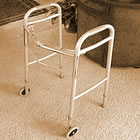|
Bare Metal or Drug-Eluting Stents in Octogenarians? Results from the XIMA Trial
|
 |
October 30, 2012 -- Patients over 80 years of age are typically excluded from randomized clinical trials involving stents or angioplasty because they are deemed sicker, with more co-morbidities: all conditions that would confound results, making it difficult to discern if the treatment in question is really efficacious for the majority of patients. And since, in most interventional cardiology trials the mean age of patients is 61, it remains unclear whether results from the majority of clinical trials are applicable to an octogenarian population.
It was therefore that XIMA, a courageous and important trial, was mounted by investigators from England and Spain to answer a question often faced by clinicians:
"I have an elderly patient with with extensive co-morbidity,
refractory angina, and a complex coronary anatomy. The patient is unsuitable for bypass surgery. So I think a stent is the correct treatment. Should I place a bare metal stent, which has a higher chance of restenosis but only requires one month of dual antiplatelet therapy (DAPT), or a drug-eluting stent, which has less risk of closing up but requires a year of DAPT which increases the risk of bleeding, a complication which can have very serious consequences in this patient population?"

A "Zimmer" frame |
Trial Description
XIMA is an acronym for "XIence or Vision for the Management of Angina in the elderly", Xience being the widely-used everolimus-eluting stent (EES), manufactured by Abbott, and Vision, the bare metal version (BMS) of that stent (the trial was funded by an unrestricted
educational grant from Abbott Vascular). Researchers hypothesized that the drug-eluting stent would prove superior in terms of a combined endpoint of mortality, heart attack (MI), stroke (CVA), need to re-open the target vessel (TVR), and severe hemorrhage at one year in patients aged 80. (In a side note, principal investigator Dr. Adam de Belder of Sussex Cardiac Centre, Brighton, England, noted that XIMA -- pronounced "Zee-mah" -- is also a play on words: in the U.K. the walkers used by elderly people are referred to as "Zimmers", after the company that manufactures them.)
The U.K. team also reached out to Spain where coprincipal investigator Dr. Jose Maria de la Torre Hernandez of H. Marqués de Valdecilla managed the recruitment of 50% of the patients; there were 800 patients enrolled from 22 centers in the two countries. 40% of the patients were female and over two-thirds were ACS or unstable angina patients. DAPT was one month for BMS; 12 months for EES -- and compliance was very high. All patients were 80 years of age or older.
Trial Results
The one-year results of the XIMA trial were presented by Dr. de Belder at the Transcatheter Cardiovascular Therapeutics late-breaking trials session on October 26. The primary composite endpoint (comprising death, major bleeding, MI, TVR, and CVA) showed no statistically significant difference between the drug-eluting (14.5%) or bare metal stents (18.7%) -- a P value of 0.092. But while the trial was negative for showing a difference in this pre-specified composite endpoint, examination of the individual components yielded important information. As expected, the revascularization rate was significantly lower in the DES group -- 2.0% vs 7.0% in the BMS group -- three-and-a-half times lower. This lower restenosis rate may have driven a two-fold reduction in the rate of heart attacks in the Xience group as well (4.3% vs 8.7%).
However, even with these large differences in MI and TVR, the composite endpoint was not met because mortality in the DES group was numerically higher (8.5% vs. 7.2%), although with a P value of 0.5 it was not statistically significant. The question of why there were more deaths in the DES group was not immediately clear, but the influencing factor for higher mortality in the DES group was the greater number of non-cardiac deaths: 5.2% for DES vs. 2.5% for BMS, statistically significant at P=0.04. Dr. de Belder stated in a press briefing that the investigators will be attempting to tease this data out prior to publication. He also commented to Angioplasty.Org that if only cardiac death, instead of all-cause mortality, had been part of the composite endpoint, the trial would probably have proven positive for DES as the superior treatment.
Takeaway for Clinicians
An encouraging outcome was that the rate of major bleeding was not different between the two groups (2.3% for DES vs. 1.7% for BMS, a P value of 0.5). In fact the bleeding rates were virtually identical through six months, and only diverged in the 6-12 month period, where the patients with drug-eluting stents suffered more bleeding, possibly due to the prolonged antiplatelet therapy needed for DES. And this was "major bleeding" as defined by TIMI, not access site bleeding. In fact almost 55% of the PCIs in these octogenarian patients were performed via the transradial approach from the wrist -- an access site that has virtually no bleeding complications.
The bottom line for clinicians trying to determine which type of stent to use for elderly patients was as follows:
- There were good clinical results with both DES and BMS
- The was no difference in mortality between groups at 1 year
- Major bleeding was similar in
both groups despite differing DAPT regimes
- Target vessel
revascularization and myocardial infarction rates were significantly lower in the
DES-treated patients
While technically a negative trial, the outcomes seen in the various components of the endpoint should inform decision-making by the cardiologist and patient as to which type of stent is most appropriate. Most importantly, the benefits of percutaneous coronary interventions for the very elderly have been confirmed as safe and effective.
Reported by Burt Cohen, October 30, 2012
|

